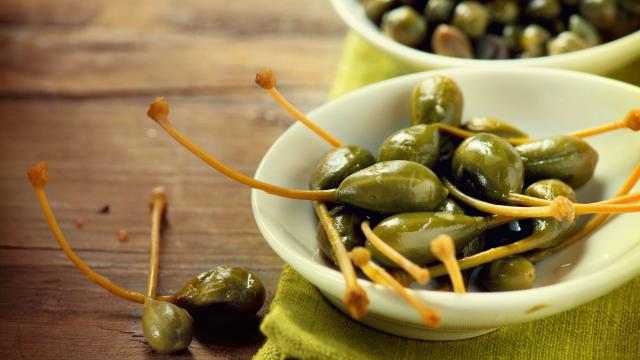As a lover of the brined and the heavily salted, I appreciate the many gifts the caper bush bestows upon us. From it, we receive not only capers, but caperberries — two things that sound like they might be the same thing, but are in fact quite different.
Capers and caperberries are both plucked from the caper bush, but at different stages of maturity. Capers — the small, intensely salty, piquant little orbs you often find on a bagel with lox — are the unopened, immature flower buds, while caperberries are the mature fruit.
Both are usually brined in some way, but caperberries are larger and more tender, with a lemony, floral flavour. Salt-packed caperberries tend to be a little crisper than their liquid-brined counterparts, which, like most pickled things, are sour and salty, with crunchy seeds that have a similar texture to the ones you’d find in a kiwi fruit.
Use caperberries like you would olives — especially in ice-cold martinis. You can roast them whole, with their stems still on, alongside a protein or all by themselves, or toss them in a big bowl of pasta. They also make a superb pizza topping: Slice them into little disks and scatter them around like pepperoni.
Capers, on the other hand, are smaller and have a sharper flavour, but are still quite bright and best used as a garnish (or fried as a smol bar snack). Capers are harvested before they bloom and rated by size, with the smallest — which are called “non-pareil,” which means “has no equal” — being the most desirable. Pantelleria capers, which are hand-picked on an island between Sicily and Tunisia and stored fermented and packed in sea salt, are the fanciest, and best added as a garnish to allow you to appreciate their complex flavour.
But all capers are pretty good. They are good on chicken, they are good on fish, they are good on salads, they are good on pasta, and they are good in compound butter. (They are good in a whole lot of savoury things, is what I’m saying.)
Both capers and caperberries are typically either packed dry in salt or in jars with a liquid brine. The salt-packed versions of both are, predictably, very salty, so it’s usually a good idea to give them a rinse (or even an overnight soak) to reel in the salinity before adding them to your food. Some people also recommend similar moves for the brined boys, but I, uh, never do that, because I really like salt. (If eating capers directly from the jar is wrong, I will never, ever be “right.”)

Leave a Reply
You must be logged in to post a comment.